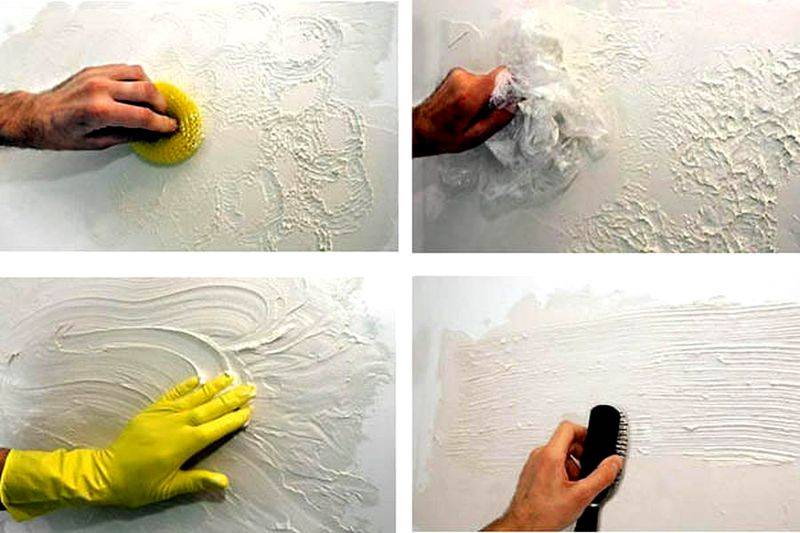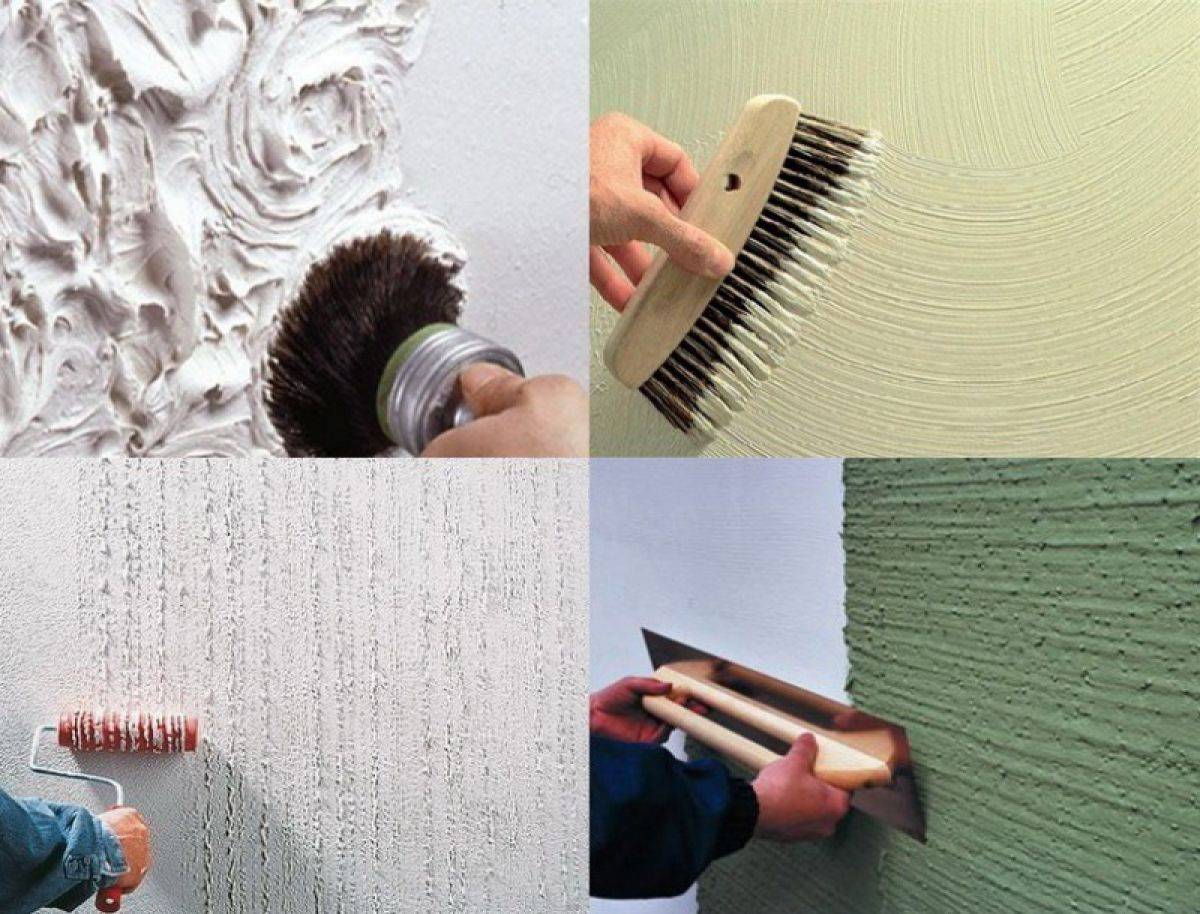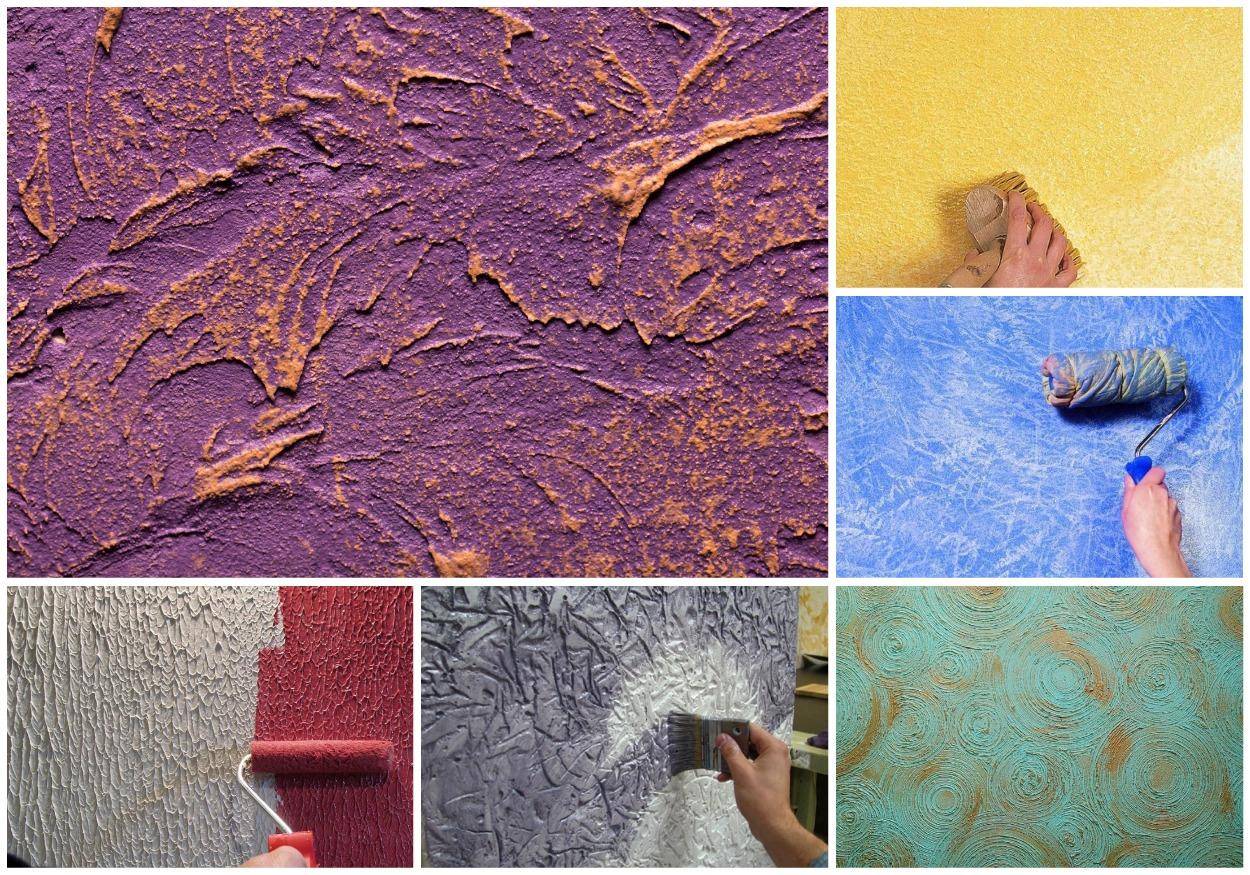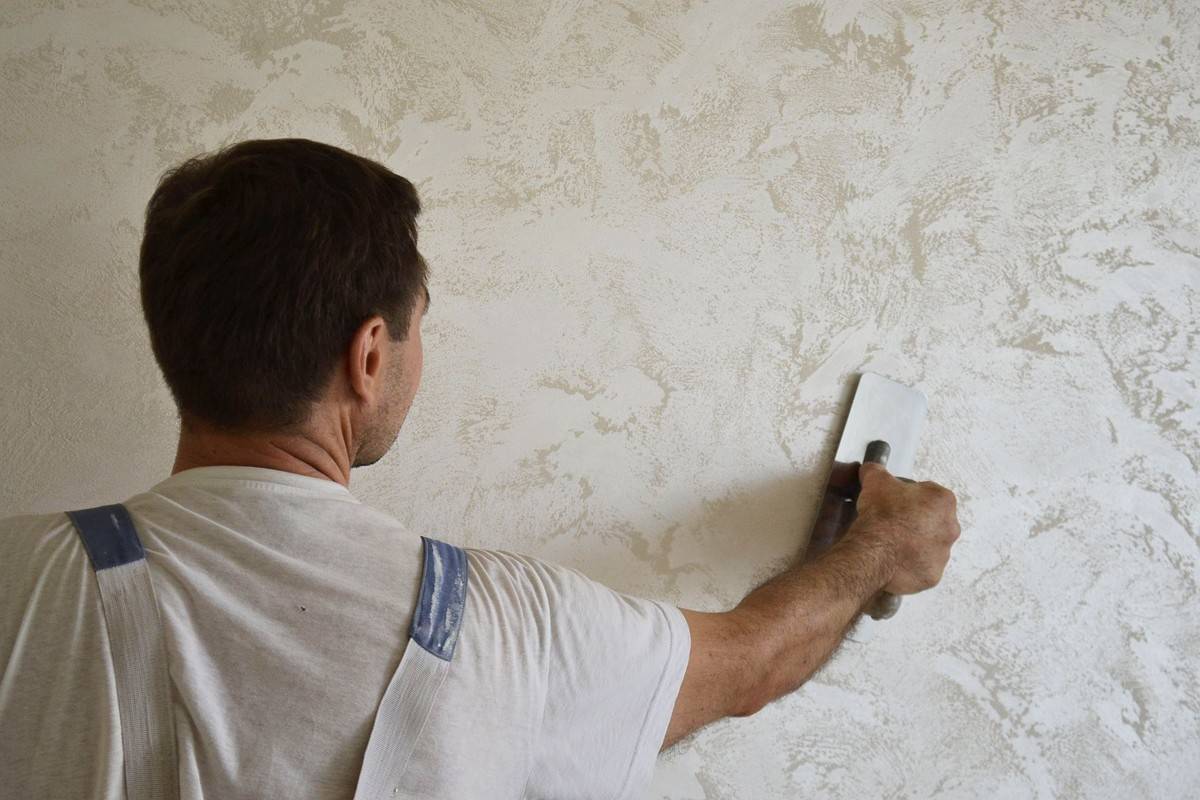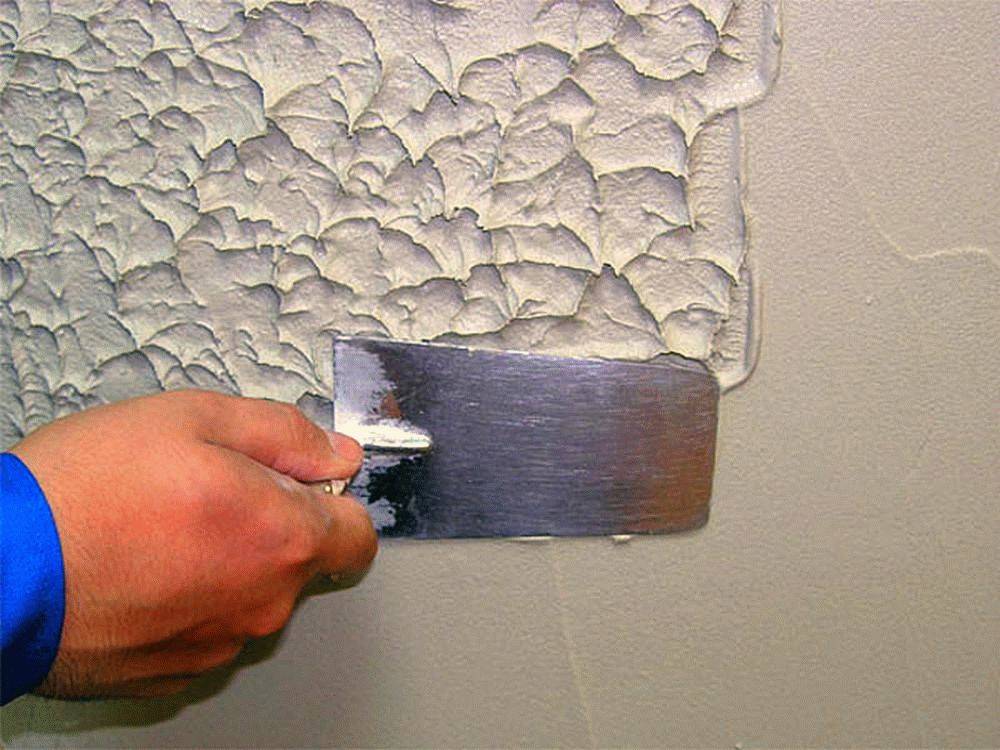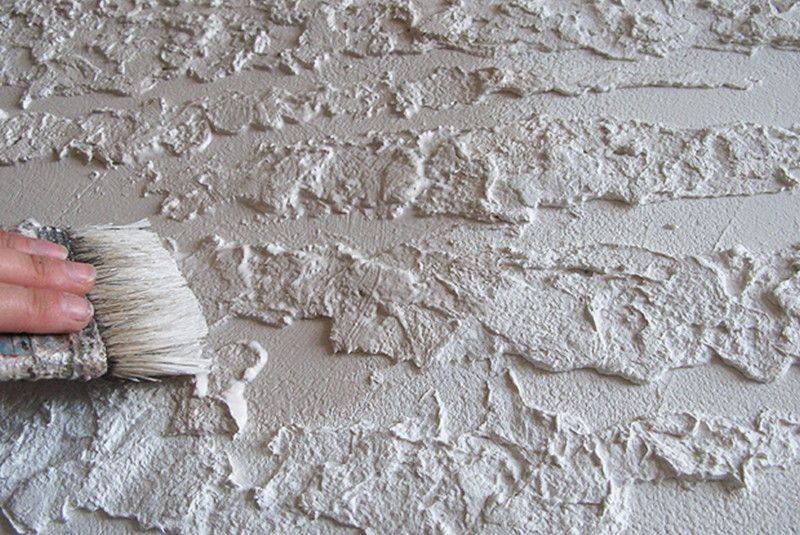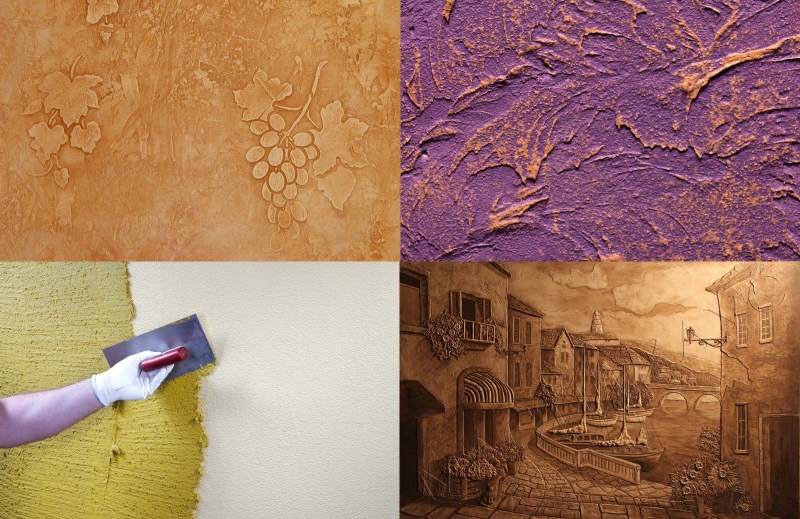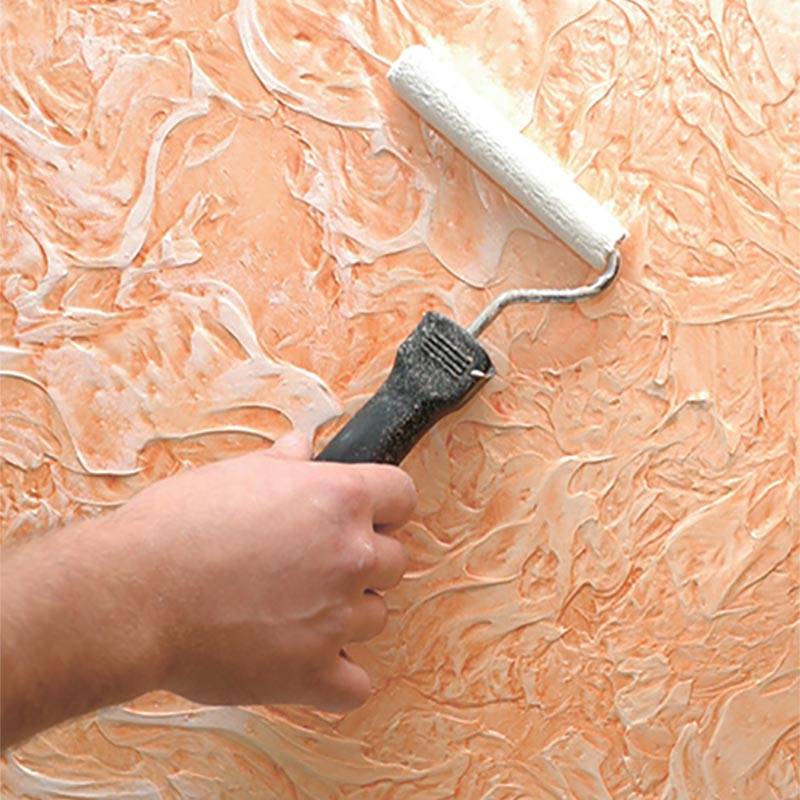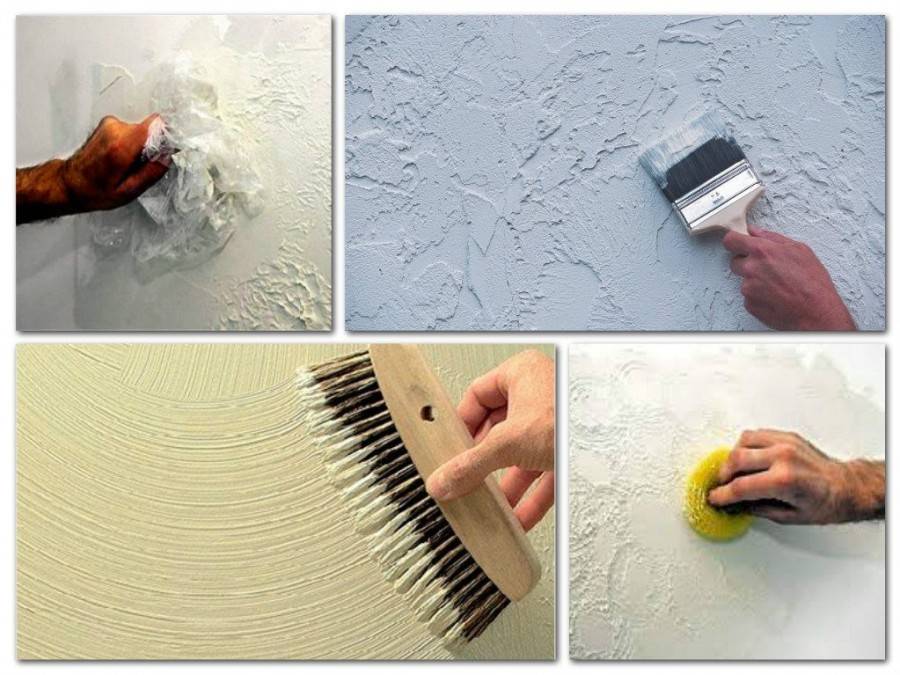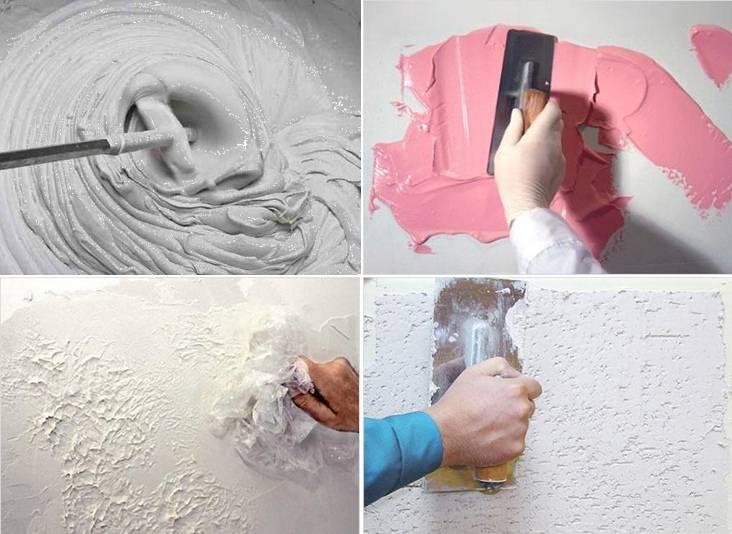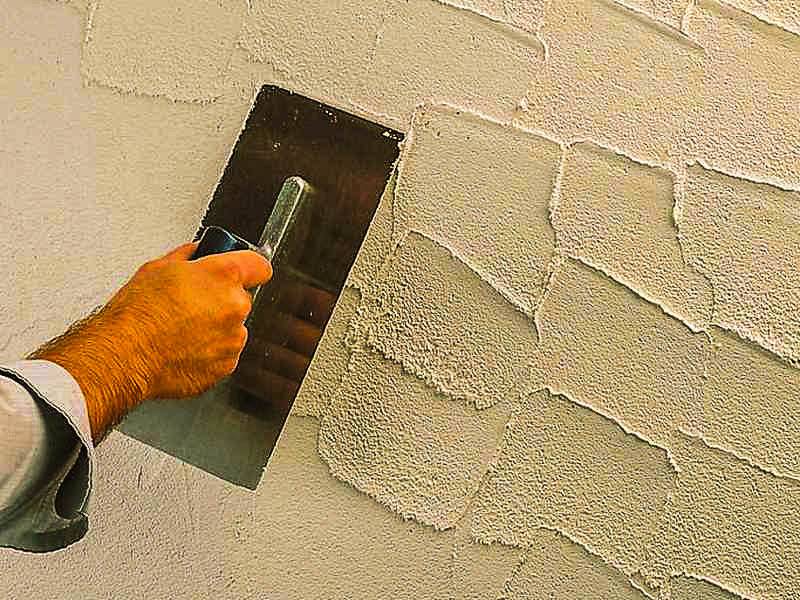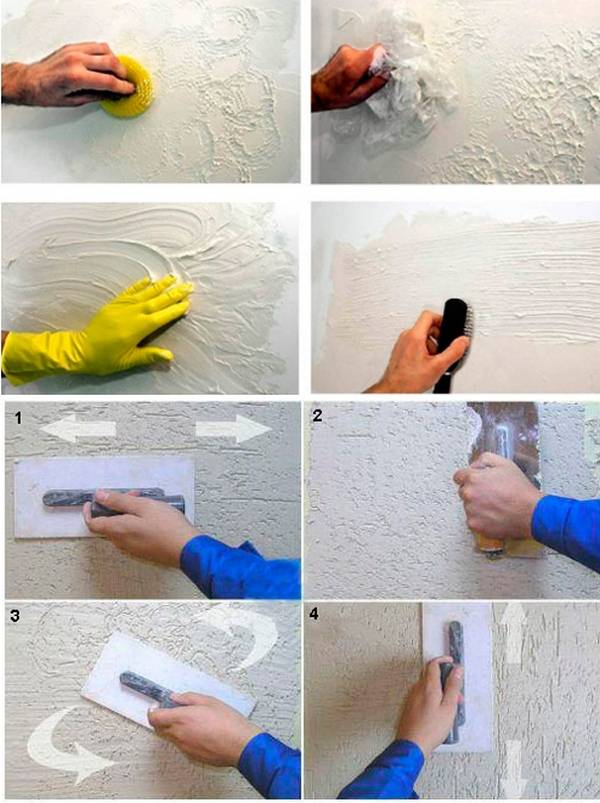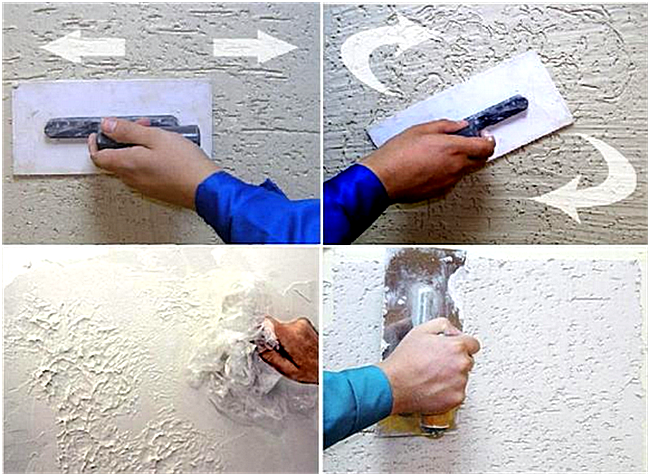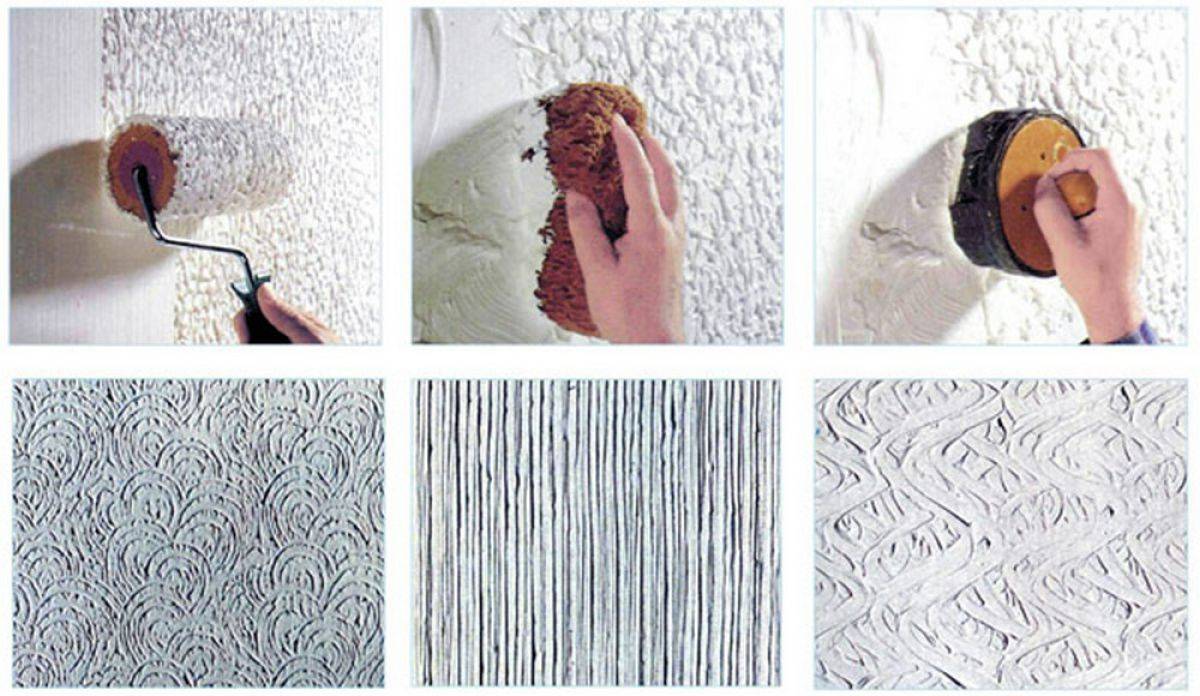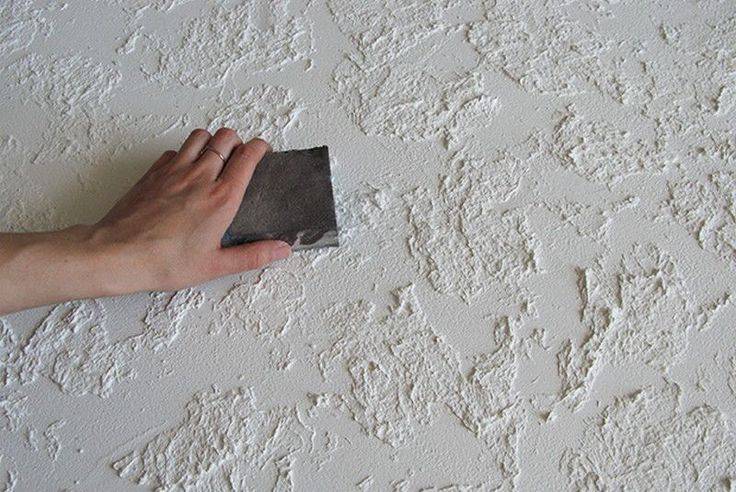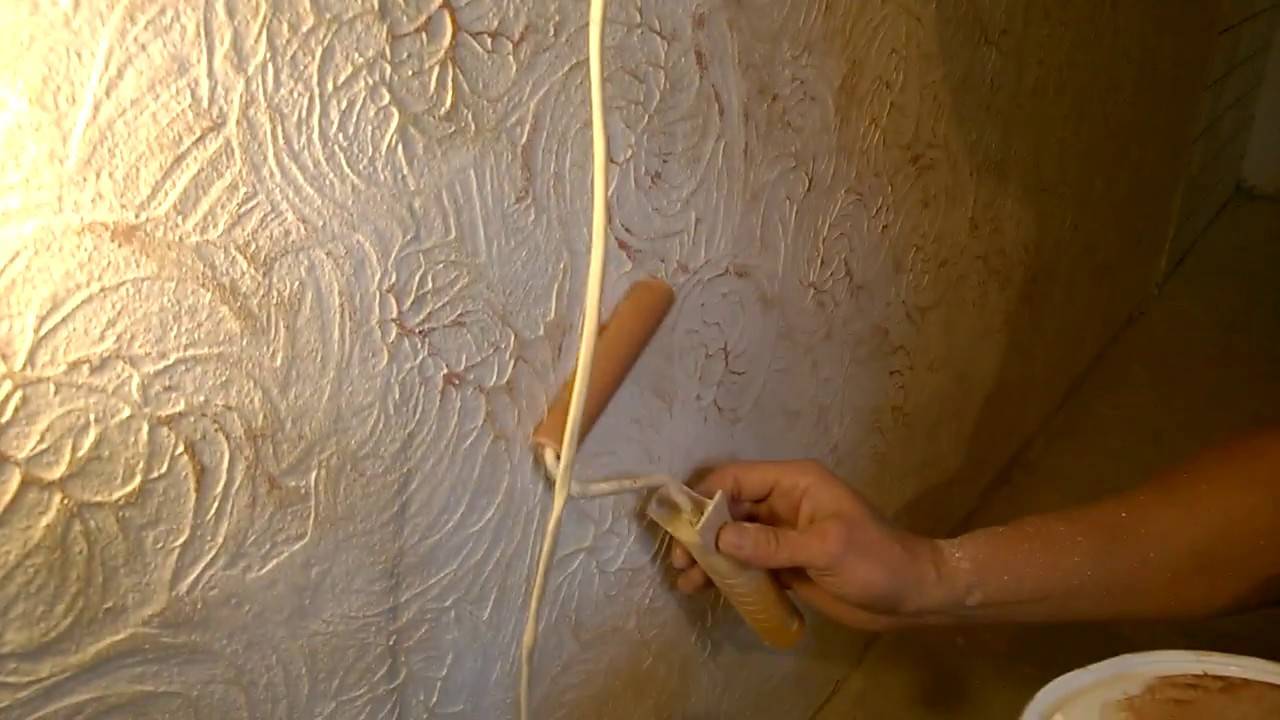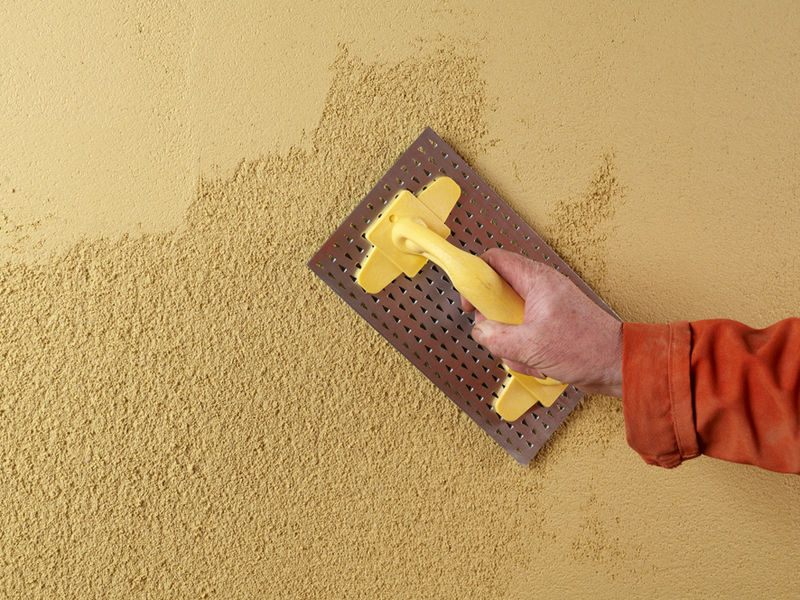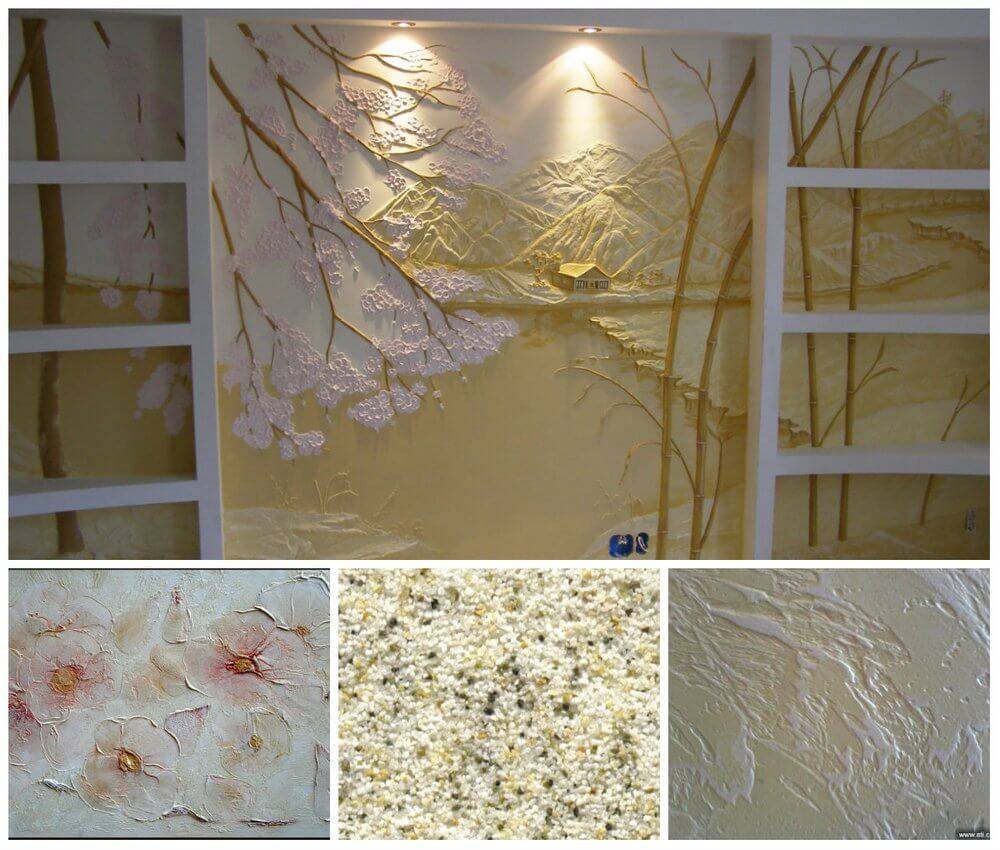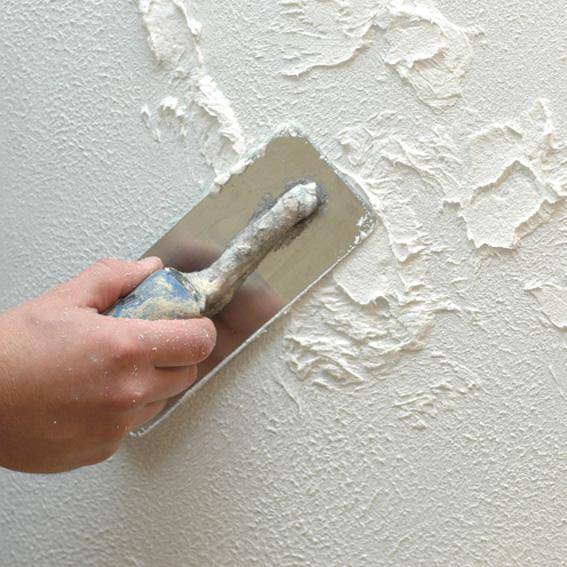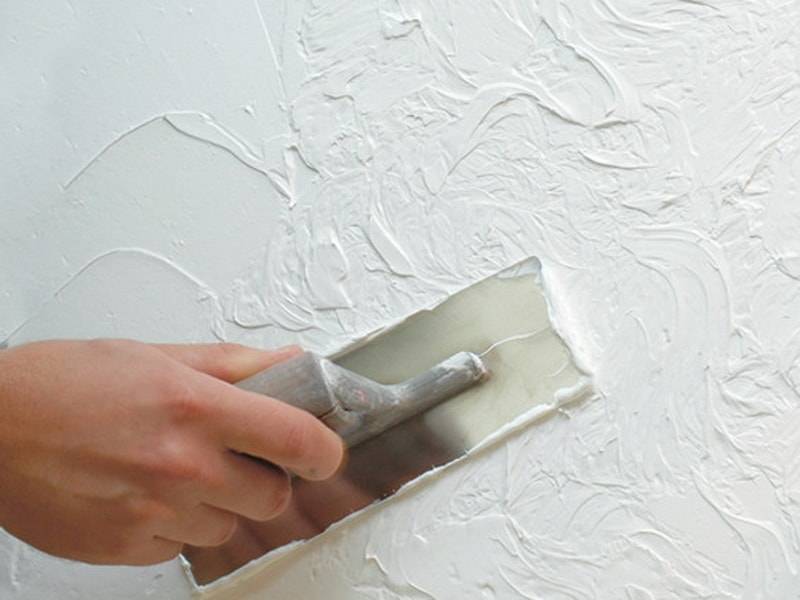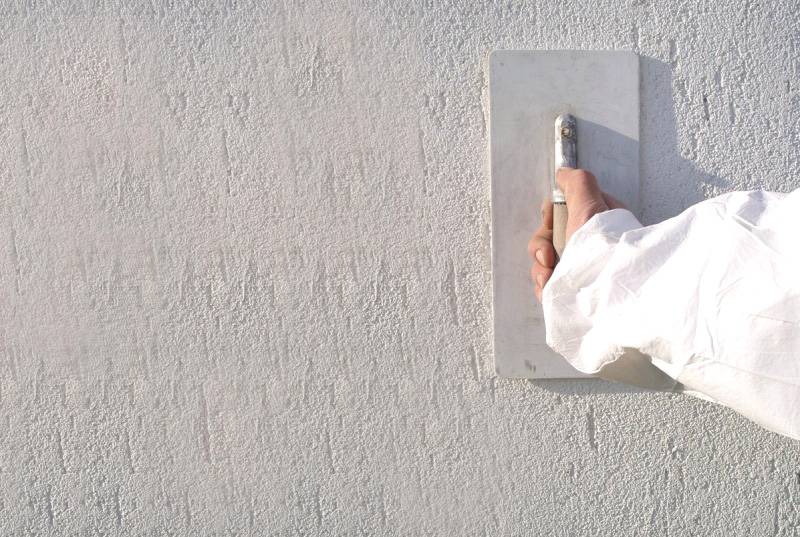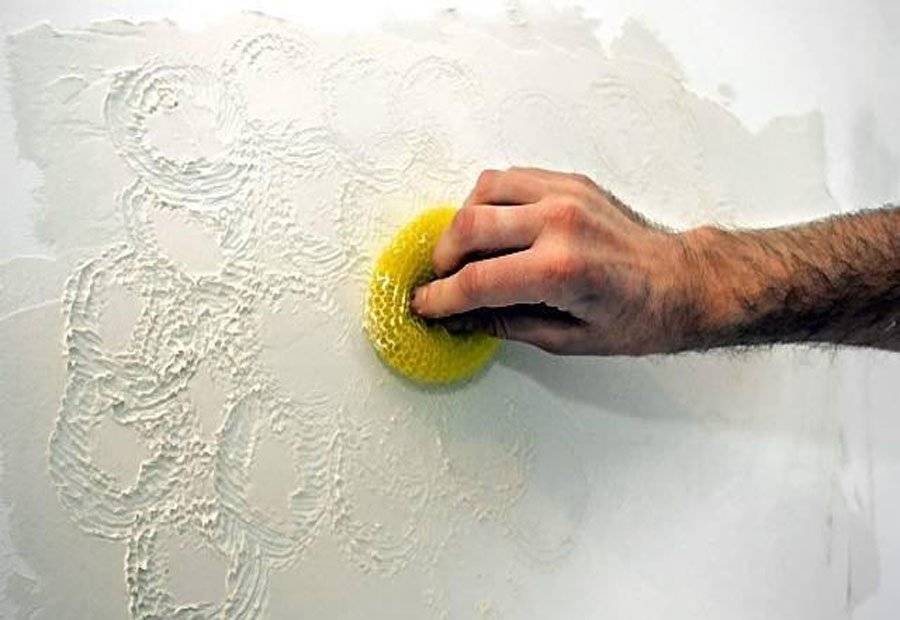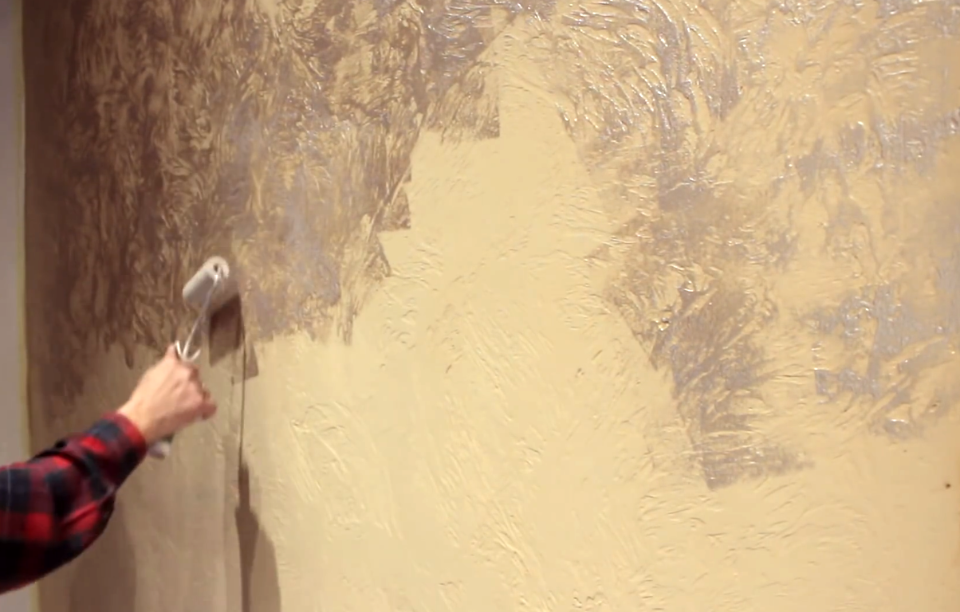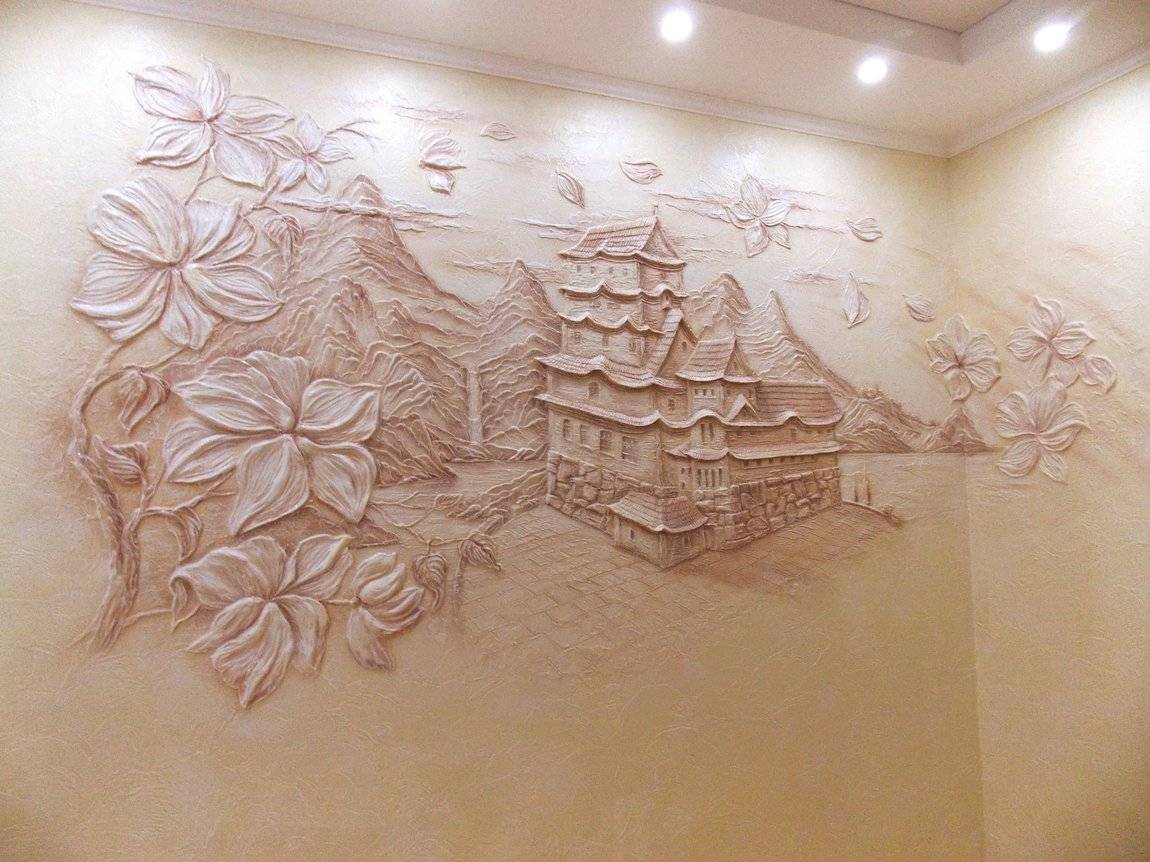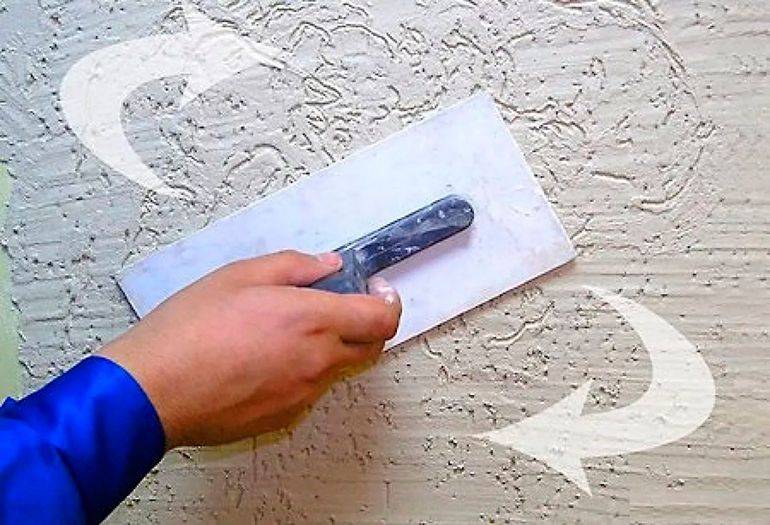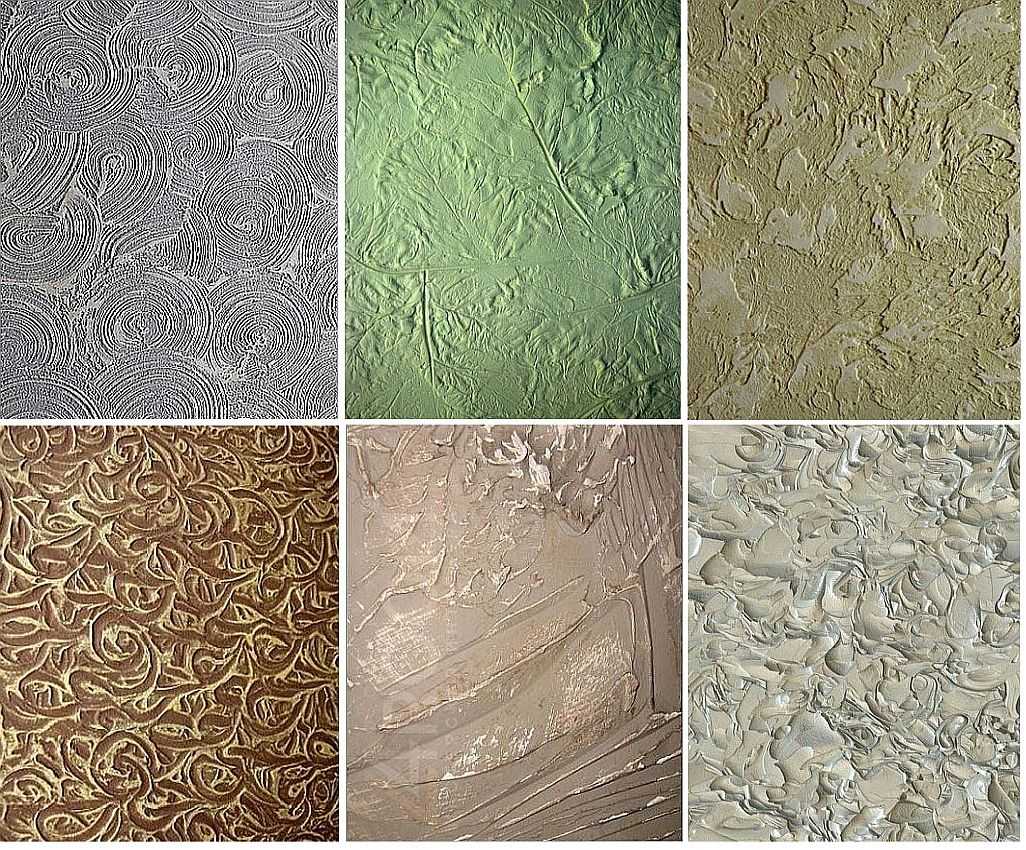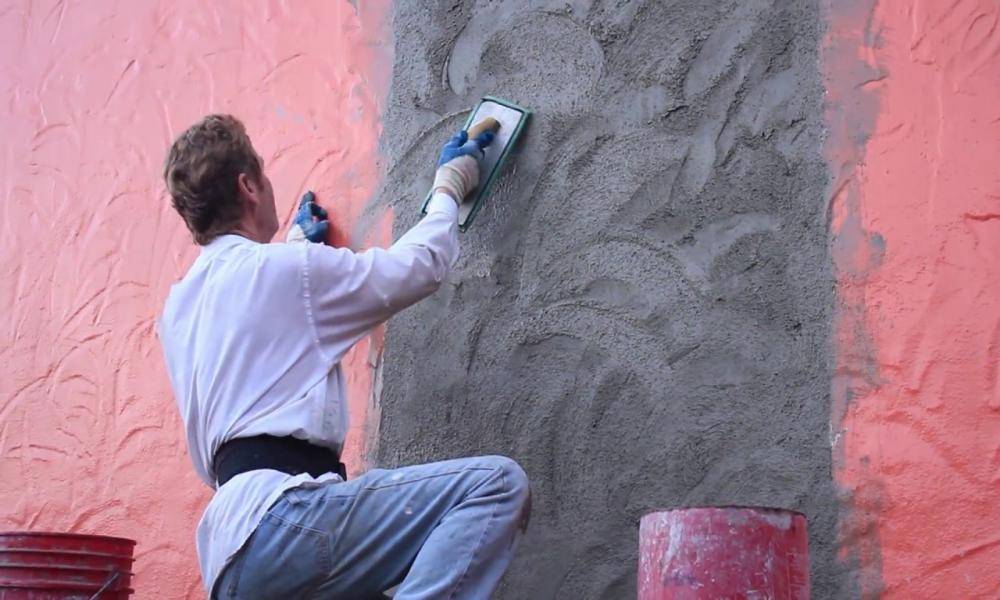What you need to work
A beginner plasterer needs working tools to achieve a beautiful and durable finish. They are widely represented in the market today. The availability of ready-made working compositions greatly simplifies the process. You should also figure out how to properly apply decorative plaster, which can be viscous or dry.
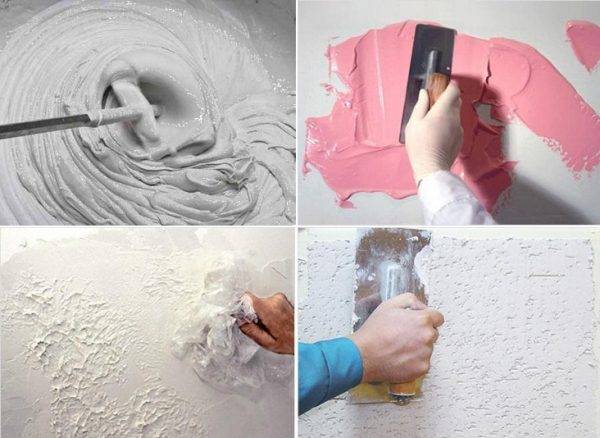
Before starting finishing work, you should decide on the type of texture to be created and the plaster composition you need for it. There are several known techniques for applying such a finish, which creates the effect of natural irregularities on the surface of the walls. With all the apparent simplicity of this plastering technology, there are fundamental nuances that should be taken into account in the finishing process.
When choosing a ready-made working mixture, take into account:
- features of the material on which the finishing layer will be applied;
- humidity level;
- temperature regime;
- a type of finish that can create various reliefs on the surface of the walls.
Before starting work, you should inspect the walls. If the condition of the plaster layer on them is poor, then it may be necessary to apply a new base. To do this, you will have to buy a suitable filler. If there are too deep dents on the walls, install drywall sheets.
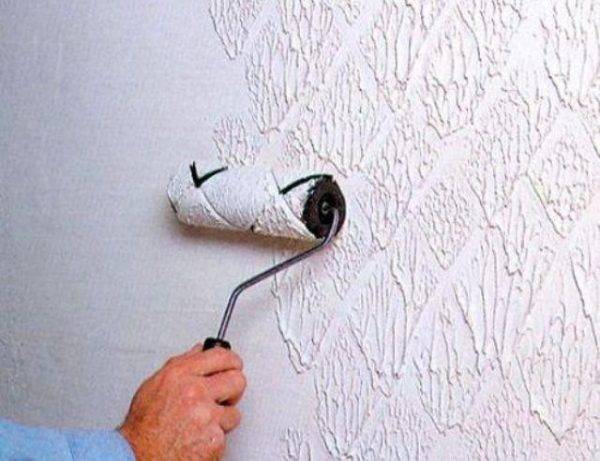
When buying ready-made working compositions, you need to pay attention to the fact that some of them, when dried, may give a lighter or darker shade. In addition to the mixture itself, you will need to purchase a primer for preparatory work
Experts recommend using a primer for such a cladding that penetrates deeply into the base of the plaster and provides high adhesion to the wall surface.
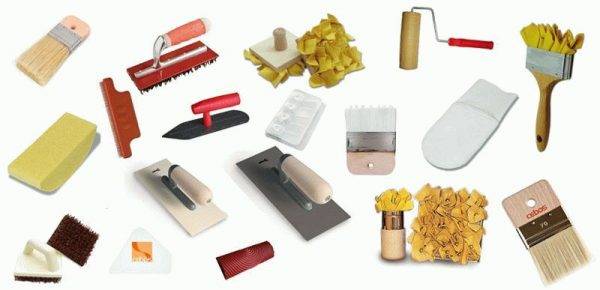
Before you start creating a decor, you need to prepare:
- metal and rubber spatulas of different sizes;
- graters and half-graters for smoothing the mixture and giving it the desired texture;
- foam textured and paint rollers;
- bevel with teeth for relief;
- paint brushes with stiff bristles for a subtle relief;
- trowel for Venetian plaster.
Before purchasing a tool, you should choose the type of finish and study the technology of its application. This will allow you to purchase those devices that will be needed in the work.
What kind of putty can I use?
All types of plaster putty are used to create decorative surfaces. The ideal option is the finish type Knauf Uniflot, Knauf Rotband, Ceresit CT127 or their analogues.
- A high-strength compound, similar to an adhesive, called Knauf Uniflot, is intended only for interior work. It has a low shrinkage rate and virtually no cracking.
- Knauf Rotband plaster is used for plastering concrete walls and ceilings - its adhesion (adhesion) is excellent. The surface is very flat and smooth. The mixture has a reduced consumption and is used even in rooms with high humidity.
- Ceresit CT127 white polymer putty is suitable only for interior work. It can be applied on many types of substrates, including concrete, cement-sand and plaster.
The price for a regular putty is:
finishing putty
Acrylic, silicone and other types of polymer putties are well suited for creating decorative surfaces. Fillers (sand, flock, stone chips, etc.) introduced into them are evenly distributed. Cheaper cement-based plaster is used for facades.
Stages of work
Wall decoration with decorative plaster takes place in several stages:
The choice of texture.Considering that different types of plaster are made from different materials, then the surface for application must be prepared accordingly. The technology of application and, as a result, the appearance of the walls depends on the texture.
Some types of textures can hide surface defects, while others, on the contrary, are applied only to a perfectly flat wall, before applying which it is important to properly prepare the surface.
Surface preparation. The essence of this process is to ensure good adhesion between the wall and the plastering compound.
The process of preparing walls differs depending on the material from which they are erected. While brick and concrete walls only need cleaning and leveling, wood walls require the use of plaster mesh, wooden battens or reed mats.
The choice of plaster. In addition to the fact that when choosing a composition for interior wall decoration, they are repelled by the design of the room, they also take into account practical properties
You need to pay attention to the level of humidity in the room, temperature, operating conditions, the condition of the building and its location. Depending on the combination of the listed criteria, you need to choose the most suitable option that will provide the desired appearance of the walls, high strength and resistance to various external influences
If there is no suitable one among the ready-made compositions, then you can prepare it yourself.
Application. Direct finishing of the surface of the walls, giving them the desired texture, design. Such a process should be carried out as accurately and efficiently as possible, since the duration of the operation of the finishing material depends on it.
REFERENCE: in houses that are located near highways or railways, it is recommended to use plaster for interior decoration with increased strength indicators, so that during operation you will not encounter the problem of surface cracking.
Consumption for 1 m2
Before starting finishing work using decorative plaster, it is important to make a competent calculation of the material. As a rule, it is customary to consider the consumption of the mixture per square meter.
Decorative plaster perfectly imitates stones, wood or leather. Despite its cost, it is quite budgetary in terms of consumption. Most often, the consumption per square meter of a wall or ceiling is from one kilogram to one and a half.
Plaster, reminiscent of wood in texture, has the lowest consumption. The total layer thickness should not be more than one centimeter.
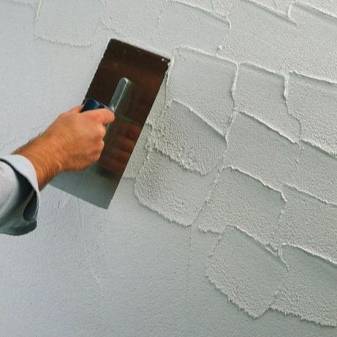
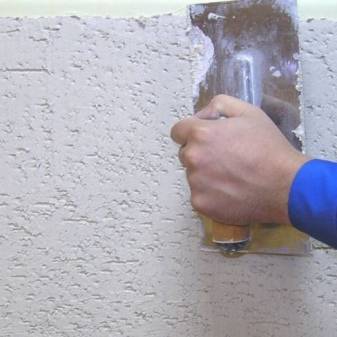
Structural plaster is made from a mixture of acrylic, cement or gypsum. This mixture is sold in packs of 25 kilograms. To decorate a wall with an area of ten square meters, one or two bags are needed.
A mixture based on acrylic dispersions is homogeneous in consistency with the presence of fine grains in it. The size of these grains does not exceed two millimeters. Ready-made plaster has a rather tangible consumption. In the presence of a fraction of one millimeter, the consumption is two and a half kilograms per square meter of the wall or ceiling.
This plaster is usually sold in plastic packaging of 15 kilograms. For a 10 meter wall, you need about two plastic bags. This amount of material will be needed to apply one layer of decorative plaster.
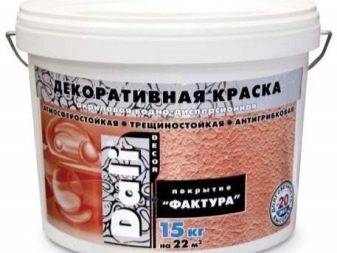

Structural material, which includes marble chips or a mixture of marble and granite chips, is in great demand. The layer of material can be from one to three millimeters. It depends on the required texture depth. To apply material to a wall of 10 square meters, you will need one pack of material with a volume of 25 kilograms.
If we consider a structural material, then it is most often used when decorating a fireplace. A solution of this plaster is sold in plastic packaging of 15 kilograms.To apply plaster to a wall of ten square meters, you need to buy two packs of material.
We should also mention the decorative plaster "Bark beetle". The consumption of this tool is from 2.5 to 4 kilograms per square meter. This variation is due to the different grain sizes in the structure of the product and the thickness of the layer.
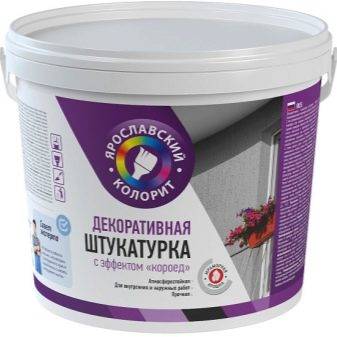
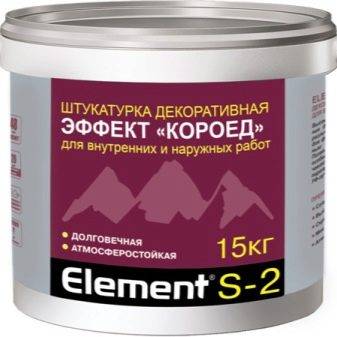
Still, before buying, you should consult with the seller in the hardware store. The specialist will accurately determine the possible consumption of this type of decorative plaster. It will not be superfluous to familiarize yourself with the information on the material on the package.
Venetian plaster allows you to create an imitation of marble in all its splendor on the wall. In terms of consumption, it is the most budgetary. The savings are due to the perfectly leveled surface. Considering the cost of the work and the price of the material itself, Venetian plaster is the most expensive.
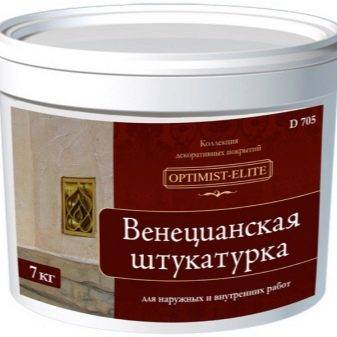

Scope of application
This tool is considered by many experts to be one of the most versatile types of finishing material. It can be used on any surface. The result is a very interesting and intricate relief of the walls and ceiling.
The widespread use of plaster is due to its good vapor permeability, durability and resistance to various natural influences.
When using this material in a children's room, it is worth choosing the composition carefully. Decorative plaster should not contain synthetic resin. When applying material to walls, do not make sharp corners.
It's important to think about your child's safety


In the bathroom and toilet, it is worth using a cement-based material.
For the kitchen area, it is worth using glass and plastic aprons. This is especially true for the cooking and dishwashing areas. For those looking to use decorative plaster in the kitchen, experts recommend covering the walls with an additional coat of paint or clear varnish. Such additional protective equipment will help protect walls from grease and soot, which are simply inevitable in the kitchen.
There is a special type of material on sale that is intended for outdoor use. This type of plaster is absolutely not suitable for using it at home. This is due to the constituent substances. They give the plaster additional resistance and strength to the effects of snow, rain and sun.
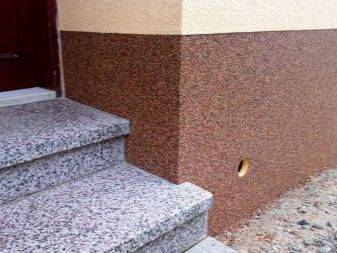
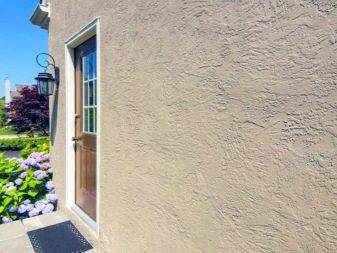
Other mixtures are suitable for indoor use only. Such decorative plaster is environmentally friendly and its composition contains natural ingredients. This material cannot be used for finishing the facades of buildings. Due to the natural composition and the absence of aggressive components, the material will not withstand the effects of natural disasters.
In specialized stores, you can also find universal plaster. It is permissible to use it in residential apartments. It has also proven itself well when used on building facades. The composition of such decorative plaster contains substances that are safe for people. The composition also includes special components that extend the life of the material on the facades. This type of decorative plaster is the most expensive.
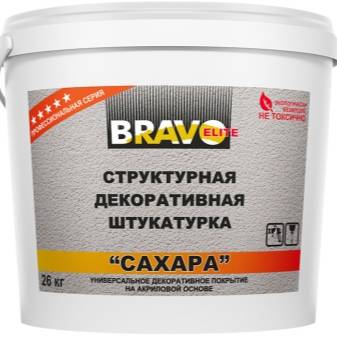
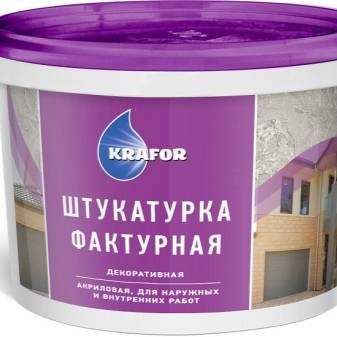
Many builders are sure that such plaster looks great in rooms with a large area. With the help of decorative plaster, all walls or its small fragments are finished. Designers are sure that some types of material are able to visually increase the area of the room.
Currently, the material can be applied to wood, drywall or brick. As a base, you can use a concrete or already plastered wall. A plastic surface is not the best option for applying decorative plaster
It is a fairly tough material, so it is important that it is applied correctly.
It can also be used in the hallway.She will be able to endure minor mechanical damage that can happen in everyday life.
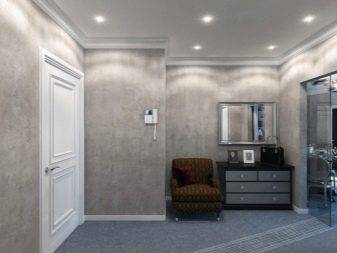
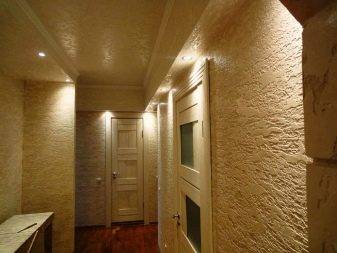
Types of decorative plaster
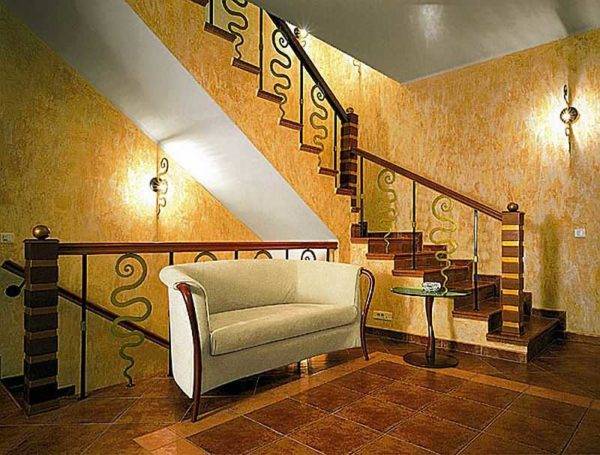
Decorative plaster - a marvelous interior decoration
Decorative plaster is used for finishing walls and ceilings indoors, building facades. The basis can be various substances of both natural (gypsum, cement, marble dust) and artificial (acrylic, silicone, silicate) origin. It is called so because it forms an attractive surface with a different texture - from smooth as marble Venetian plaster to embossed stone or "under a fur coat". The number of options is endless - the application of decorative plaster is a creative process and it is hardly possible to repeat it exactly. This is another plus of this type of finish.
By the type of surface formed, the following types of decorative plaster are distinguished:
- Embossed. After applying such compositions, some inhomogeneities and irregularities are often formed on the surface, that is, they create a relief. Their plus is the low requirements for the preparation of the base. It must be strong, must not crumble. There should also be no significant differences, but perfect smoothness is not required.
-
Textured. The relief is formed due to various inclusions - sand of different grain size, stone chips, mica plates, etc. Application of this type of decorative plaster - with spatulas (metal, plastic, rubber - depending on the composition). Usually no other special tools are used.
-
Structural. Plastic, usually homogeneous plaster. The relief is created using all sorts of devices - rollers, special floats, using various techniques. It takes a lot of skill and artistic flair to make structural plaster look organic.
-
-
Smooth. In this category, there is only one subspecies - Venetian plaster, but they allow them to create surfaces with a different appearance. It is a plastic mass, often translucent. It contains dust of marble, malachite and other natural materials. It can be used to imitate marble, cork, leather, silk, precious woods, various metals, finishing with malachite, granite.
It must be said right away that textured and plastic plasters are often difficult to separate, since different techniques can be used on the same composition. The photo below shows options for only one type of plaster - different techniques for applying decorative plaster allow you to get very different surfaces.
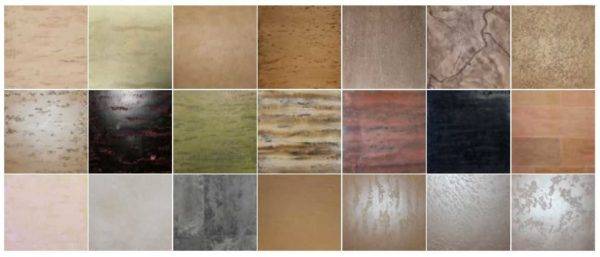
Surface options that can be made with ONE compound using different application techniques
Some decorative plasters are so flexible that they can be used to create a work of art. The result is very beautiful and original panels.
By changing the application of decorative plaster, all these various reliefs are obtained - from simple to complex.
It is worth considering their division according to the area of application. There are two large groups - for outdoor and indoor use. There are also universal formulations, but rarely. Almost all the compositions mentioned above are for internal work. These are more interior solutions. Some of them are abrasion resistant, some can be washed with detergents and even brushes, but they will not withstand the harsh outdoor conditions.
For outdoor use, some types of textured plaster are suitable - bark beetle, for example. This type of finishing material is just one of the universal ones. It can also be seen on the facade, indoors. In apartments, these are usually corridors and hallways, in offices and institutions, corridors or office premises can be decorated in this way.
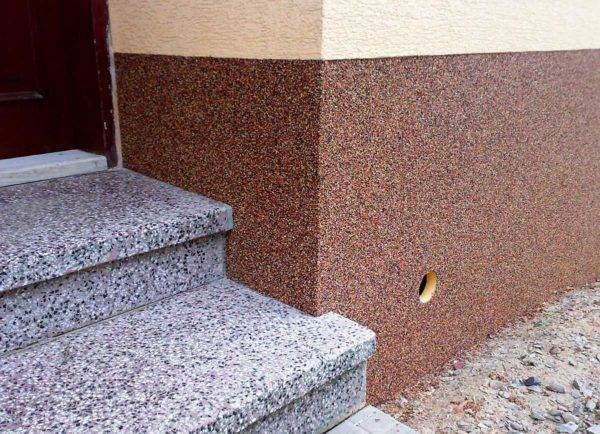
An example of finishing a house with decorative plaster from the outside: stone plaster on the plinth, above - on the walls - bark beetle
Putties for outdoor use generally have a coarser structure, contain components that increase resistance to UV and other climatic influences. In this category there are specific plasters - stone. They consist of small fractions of natural stones in a binder solution. The application of this type of decorative plaster is simply a trowel or a stainless float. Other elements are rarely used. On facades and fences, creating reliefs is not a good idea - the dust will clog and spoil the appearance, and it is not easy to wash it out.
Structural
Methods for applying decorative plaster to obtain a structure involve the use of inhomogeneous granular compositions. A kind of material is obtained by adding small pebbles, quartz fragments, wood fibers, etc. to the plaster. The finishing material is made on the basis of cement and limestone. Synthetic latexes or silicates are also added to the composition. It is better to select the composition from ready-made mixtures. This is the only way to achieve good results. If you mix the components yourself, a good result is not guaranteed.
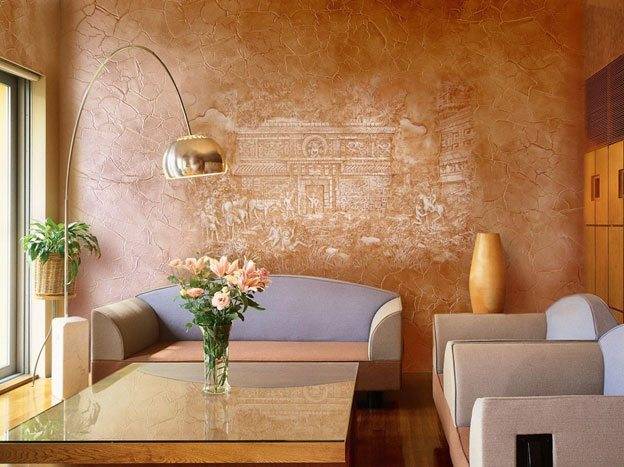 For the preparation of high-quality plaster, it is better to use ready-made mixtures.
For the preparation of high-quality plaster, it is better to use ready-made mixtures.
Decorating the walls with textured plaster is easier if you use compositions based on aqueous solvents. This is due to the fact that before applying decorative plaster with your own hands, you do not have to "evacuate" the tenants of the apartment. The water-based material does not have a strong odor.
Wall decoration with plaster of the type in question is easy. This is due to the high plasticity of the material and its obedience during work. The technology for applying decorative plaster is simple and convenient. The work can be done immediately. There is no need to prepare the mixture as it is sold already in liquid form in cans or buckets.
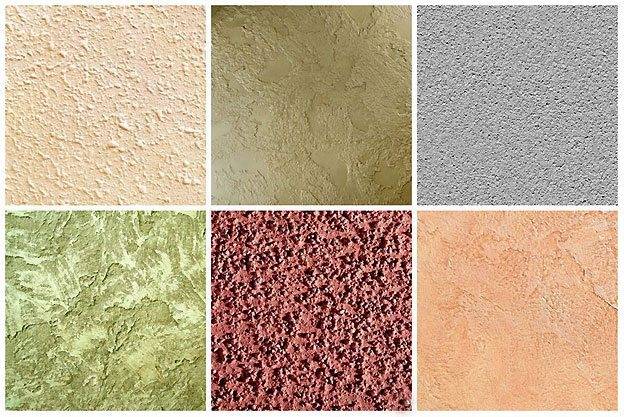 With the help of decorative plaster, you can create any structure in different shades.
With the help of decorative plaster, you can create any structure in different shades.
The application technique is as follows:
- It is necessary to prepare materials and tools for decorative plaster. For the structural composition, a roller, trowel or spatula is required.
- Before laying decorative plaster, you need to prepare the surface. A perfectly flat base is not required. The thickness of the plaster layer and its structure are capable of hiding small defects. First, the surface is cleaned of dirt, dust and grease. After that, knock down the bulges and cover up large cracks and potholes.
- A clean and dry substrate is strengthened with a primer. With it, decorative paints and plasters will adhere better to the surface. This layer also prevents moisture exchange between the substrate and the finishing material. Do-it-yourself decorative plastering can only be started after the wall primer has completely dried.
- The principle of the work performed is suitable for all compositions: on a mineral, silicone or silicate base. Plastering is carried out with a trowel or spatula in one layer. The coating is applied to the wall in a circular or rectilinear motion.
- After application, the layer must be allowed to dry. At the same time, it is necessary to control that the room maintains a constant temperature and humidity, there are no drafts. Failure to comply with these rules can lead to a deterioration in the quality of the decorative layer, the appearance of cracks.
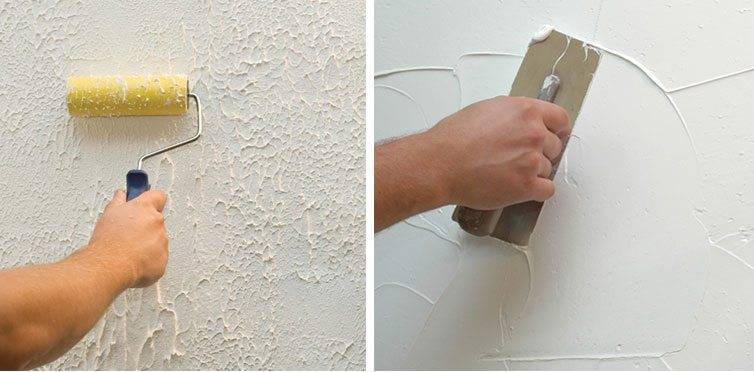 To apply the composition and create a structure, use a roller or spatula.
To apply the composition and create a structure, use a roller or spatula.
Do-it-yourself structural decorative plaster of walls is perfect for finishing common areas, for example, an entrance hall, kitchen or corridor. In some interiors, it will be able to harmoniously fit into the space of a bedroom or living room.
Before starting work, you should definitely read the manufacturer's instructions. It indicates a more specific application technique and how to use the material correctly.
Preparing the walls
Decorative plaster can be applied to any prepared surface:
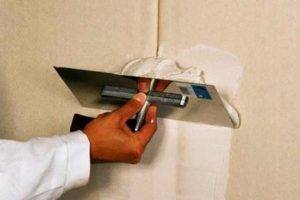
- finishing putty or leveling plaster (cement, gypsum, etc.);
- brick and concrete;
- aerated concrete;
- GKL or chipboard;
- (using mesh or shingle reinforcement).
Before starting the work process, you need to carefully prepare the walls. The surface must be clean, dry and free of dust. All traces from the previous finish are removed, cracks and irregularities must be putty.
Before plastering, the walls are primed. The primer will ensure good adhesion of the decorative material to the walls. It is worth choosing alkyd or acrylic compositions of deep penetration. For damp rooms, an antiseptic primer is chosen to protect the walls from the formation of fungi and mold.
For the preparation of walls made of smooth material such as chipboard and drywall, adhesives with quartz sand are needed. The sand will roughen and improve the adhesion of the surface to the substrate. Adhesive quartz primer can be selected from the brands: Bayramix Astar, DALI-Decor Quartz Primer, Alpina Expert, Betonokontakt.
If decorative plaster has already been applied to the walls, a new layer of material can be applied to renovate the interior. For this, it is not necessary to get rid of the previous finish. It is enough to treat the surface with an adhesive primer, which ensures reliable and strong adhesion of materials.
Reinforcement with fiberglass mesh. Some bases need reinforcement before decorative work. For example, when creating a wet facade, mineral wool or expanded polystyrene is covered with a layer of plaster with a fiberglass mesh. This is the basic leveling layer. When finishing plastering, the mixture is applied in a thin layer of 2-5 mm, at this stage the fiberglass is not needed.
Application
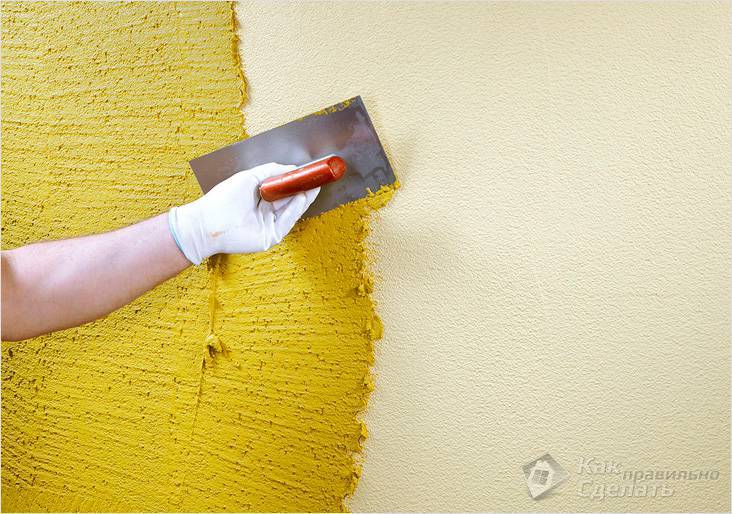 Plastering
Plastering
The solution should be prepared based on the recommendations on the packaging, then you will get the required consistency. Moreover, you need to prepare such a portion in order to select it at a time, because otherwise the solution will "grab" right in the container. This is a job that does not tolerate long smoke breaks.
You need to apply the plaster with a spatula. When it thickens a little, you can go over it with a float without undue pressure, creating the desired pattern. It is better to practice beforehand in a small area.
Most often, beginners create rains of different directions, circles, waves, crossed lines on the walls. The horizontal relief is the easiest to execute. You can also use a special curly roller, then it is much easier to apply the pattern.
All this must be done at the maximum rate, because the layer of plaster dries very quickly.
It is necessary to pay special attention to the joints of the sections to avoid sagging
Further, after 15-20 minutes, when the wall loses its wet shine, it is necessary to slightly smooth the relief using a wet trowel. It is recommended to constantly clean the trowel and immerse it in a container of water.
After complete drying (usually about 24 hours), the plaster needs to be treated with a fine sandpaper, which removes all excess.
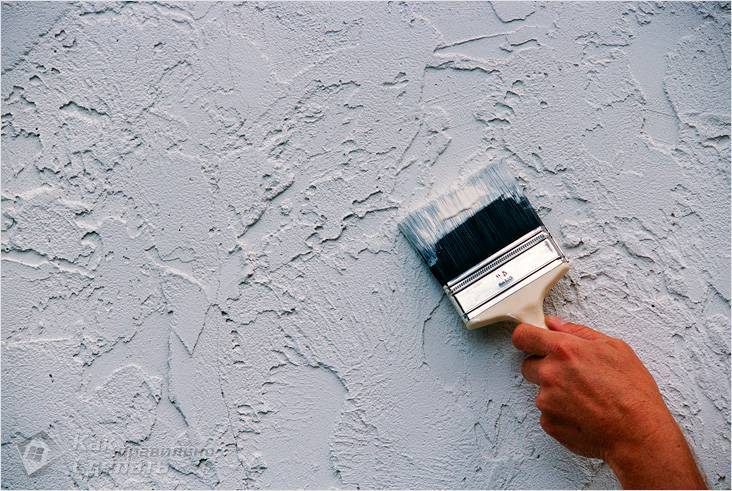 Liquid
Liquid
At this, wall decoration with decorative plaster can be considered complete. But there are people who are not satisfied with this, and they want to paint the wall. In this case, use only high quality paint that is resistant to moisture, sunlight and mechanical stress.
After the first coat has dried, apply a second coat of paint.
Applying textured plaster: video tutorials
To work, you need a tool:
- A container for preparing a solution, a mixer or other power tool with a mixing attachment.
- Trowel wide and narrow, trowel for material application, leveling and patterning.
Now, step by step, consider the technology for applying plaster and creating a decorative texture. The video below will present several methods of textured finishing, to which we will give a description.
Before starting work, the walls must be prepared: leveled with plastering or drywall.The surface is treated with a universal acrylic primer in order to bind small particles and dust, improve the adhesion of materials, and strengthen the base.
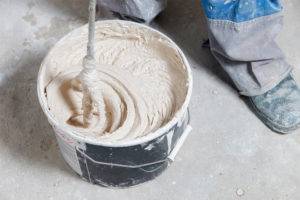
Preparation of plaster or putty from a dry mixture is as follows. Pure cold water is poured into the bucket at the rate of 0.3-0.5 liters per 1 kg of the mixture. Be sure to follow the manufacturer's instructions for water consumption! Then apply the plaster from the bag with your hands or with a scoop until it completely disappears under the water. Then the solution is mixed with a mixer or other power tool with a nozzle until completely homogeneous. As the masters say, the consistency of thick sour cream should turn out.
Base layer. A base is prepared on the wall for the future textured surface. The plaster is laid in an even layer of 2-3 mm and left to set. When the coating is not wet to the touch, apply the next layer.
Decorating. Use the same plaster as the base. A mortar with a thickness of 2-3 mm is placed on the wall with a trowel and leveled. Immediately, without waiting for drying, they create a relief surface.
You can make the texture with the same trowel or spatula: lightly pressing on one edge, draw the tool over a fresh layer of finish. Hand movements can be circular, wavy, or in an arbitrary direction.
The video below shows how to apply textured plaster with a trowel. The master makes small undulating movements on a diagonal. After drying, the tops of the relief are rubbed. Alternatively, you do not have to wait for the mixture to dry, but after the mixture has set (about 5 minutes), walk along the finish with a trowel, slightly leveling it.
The next lesson shows how to decorate a facade with a stone look. Decorative plaster is trimmed with a brush - they make pokes, leaving a rough surface. Then the texture protrusions are smoothed with a trowel. It turns out an imitation of a stone wall.
Decorative plaster for bark beetle is quite simple to perform. The material contains mineral granules, which, when leveling the mixture, leave grooves in it, similar to the moves of a bark beetle in a tree. It is enough just to apply the mixture in an even layer of 2-3.5 mm and walk in a circular motion over the entire surface with a trowel. If you rub vertically in one direction, you get the "rain" texture. Read more about this in our article.
When using curly rollers or stamps, the thickness of the decorative coating is made slightly larger (3-5 mm). A roller is carefully rolled from top to bottom, leaving a strip with a pattern. The next strip is created side by side so that the junction of the edges is not visible.
When working with a stamp, you can start from anywhere on the wall. If the tool is not homemade, then there should be no problems with joining the edges. The stamp is pressed tightly against the plaster, smoothed and removed. A textured print remains on the surface.
We have considered only a few technologies for applying textured plaster. Each method will be discussed in detail in a separate article on our website.
You can watch other master classes on decorative plastering in the video section.

